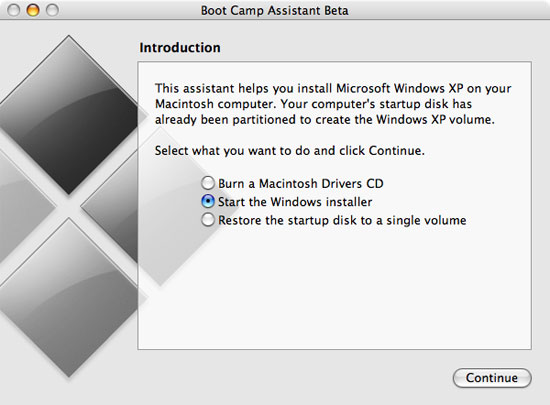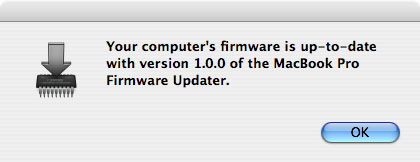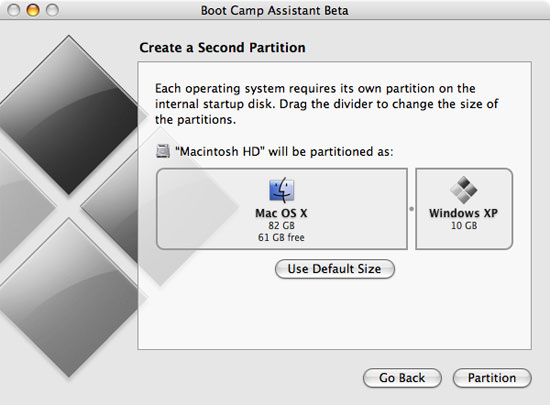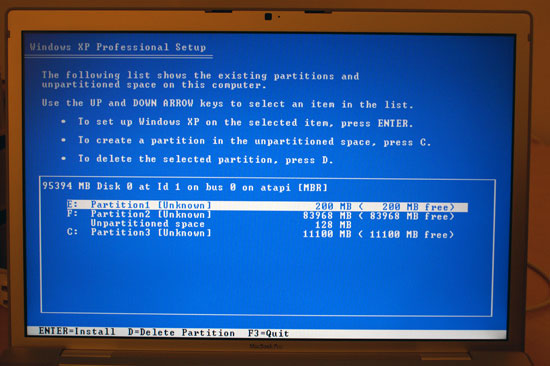Apple's MacBook Pro: Using it as a Mac and a PC
by Anand Lal Shimpi on April 13, 2006 12:00 AM EST- Posted in
- Mac
Apple's Military Aspirations
The slightly redesigned exterior, integrated iSight and performance improvements are more than enough to make the MacBook Pro stand on its own. It's rare that you can make a single upgrade and experience such a noticeable increase in performance, but as I mentioned at the beginning of this article, the MacBook Pro has a couple of features that make it even more enticing.

Apple released the first public beta of Boot Camp, an application that allows you to install Windows XP SP2 on your Intel based Mac. Apple announced that Boot Camp would be shipping with the next version of Mac OS X (10.5), codename Leopard, but until then we've got this free public beta.
The Boot Camp setup process is extremely straightforward, and a lot easier than even I expected it to be. After mounting the Boot Camp image and running the installer I was told that I needed to update my firmware before proceeding with the installation. Given that my MacBook Pro was an earlier revision (Rev C) it didn't have the updated firmware so I had to download and install it before proceeding.
Interestingly enough, the process is different on the MacBook Pro than upgrading firmware was on my PowerBook G4 and PowerMac G5; those two machines simply updated their firmware through OS X's Software Update utility, whereas the MacBook Pro requires you to go out and download the firmware update on your own. I'm not sure if this is because of the switch to Intel or something else entirely.
The firmware update gives you very little feedback or information as to what's going on: you run the program and it shuts down your MacBook Pro. You are then told to hold down the power button until the front power LED starts flashing. Once the front LED starts flashing the firmware update begins and you'll see a grey screen with a progress bar at the bottom of it. When it's done you're greeted with a ridiculously loud beep and then the system reboots and works as normal.

With the firmware updated I ran the Boot Camp assistant once more and now I was ready to begin. The assistant prompted me for a blank CD so it can burn all the drivers I'd need onto that disc. Unfortunately it's impossible for you to get the Boot Camp assistant to run on a non-Intel Mac so your only hope for creating the driver disc is on your MacBook Pro or if you have another Intel based Mac laying around.

After burning the driver CD it's time to start the actual installation process. Boot Camp comes with its own partitioning utility, and it requires a minimum of 6GB set aside for your Windows partition; I chose 10, but you can select whatever you'd like. If you actually plan on using the Windows partition on a regular basis for applications and games you may want to make it even larger (as well as opt for the larger 120GB drive). The repartitioning is non-destructive so your OS X installation, applications and documents are safe. Amazingly enough, the repartitioning only took about 2 minutes.

With the partition created and my Windows XP SP2 disc in the drive, it was time to reboot and start the installation. The Boot Camp assistant warns that you must have a Windows XP SP2 disc (either Home or Professional), a SP1 disc will not work. If all you've got is a SP1 disc then you'll have to create a slipstreamed version with SP2 yourself.
After the reboot I was dropped into the very familiar Windows XP setup process, which from this point on behaved entirely as normal. The only thing to pay attention to here is that you want to make sure you format and install to the right partition, as they aren't labeled. I selected the 10GB partition I had created earlier and chose to format it as a FAT partition (Windows setup forced FAT32 because of the size of the partition, although listing FAT). The benefit to using a FAT32 partition is that the partition will be read and write accessible from within OS X; if you create a NTFS partition you'll only be able to read from it in OS X, you won't be able to write to it.

With the partition formatted (a quick format works just fine), the rest of the Windows install proceeded as normal. All reboots went directly into Windows setup and I hardly remembered that I was doing all of this on a Mac.










52 Comments
View All Comments
Calin - Thursday, April 13, 2006 - link
This could be thanks to slower drivers in BootCamp Windows XP, or slower hard drive access/speed. Everything else is a disadvantage for VM: one more level of indirection in disk access, less memory, running the OS X behind the VM.Could you do some disk speed comparation between VM and native XP?
BigLan - Thursday, April 13, 2006 - link
I think it's going to be hard drive speed throwing off the benchmarks. The BootCamp partition is going to be at the outer edge of the disk, with much slower speeds than the VM client virtual drive which is on the faster Apple partition.I'm not sure if it's possible to assign the entire HD to a windows partition using Bootcamp, but that's about the only way i can think of to level the playing field.
Calin - Friday, April 14, 2006 - link
To nitpick, it would be at the center of the hard drive, not at the outer edge :) (ok, based on sector numbers, which starts at the edge).Near the "end" of the hard drive, the transfer speed is reduced (there are fewer bytes on a full circle).
jimmy43 - Thursday, April 13, 2006 - link
Excellent Review. This may be my first laptop purchase, seems to have everything I could possibly want.monsoon - Thursday, April 13, 2006 - link
Hello Anand,...i'm waiting for Parallels to finalize their VT release and maybe Merom Macs too...
I was wondering if the ONE CORE only VT tech is to be the final result of their virtualization software or just a middle-step.
Seems to me it's rather poor a solution ( ok, it's the best out there for now ) to use a dual-core computer to run both OS on a single core
=/
Better would be smart distribution of tasks to the CPU depending on which OS is actually under load...
...any thoughts / info on that ?
Thanks for your nice review !=)
plinden - Thursday, April 13, 2006 - link
Looking at CPU load while running Parallels VM, I see the load spread evenly over both processors (usually < 10% total CPU except at boot, when it reaches 150% CPU). It's just that the VM itself sees itself as running on a single processor.
shuttleboi - Thursday, April 13, 2006 - link
I've read that the ATI X1600 in the Mac can run games well, but only IF you overclock the GPU. I can't imagine the Mac getting any hotter than it already supposedly is, and the idea of overclocking an already hot laptop is not appealing.JoKeRr - Thursday, April 13, 2006 - link
Overall I enjoyed it.Would have been nice to see a comparison of screen brightness, as apple claimed 67% brighter!
And also, the slowness in windows, could it be related to chipset driver stuff?? And what's the gaming experience so far like?? Would it be similar to a desktop 6600 or 6600gt??
Thank you.
rolls - Friday, April 14, 2006 - link
Very interesting numbers all round.35% improvement in iTunes when comparing a single core 1.5GHz 7447 with the old slow bus etc, and a new 33% faster dual core intel CPU. 50% improvement in H.264 encoding etc. These numbers suggest that had Apple stuck with Freescale and moved to e600 core based systems, performance figures could have been off the scale. If only...
JarredWalton - Thursday, April 13, 2006 - link
On paper the X1600 Pro desktop cards actually look pretty decent. 12 pipelines at 500 MHz, with 800 MHz RAM. I would have thought they would at least give the 6600GT a run for the money, given how X1800 compares to 7800. Amazingly (to me), the X1600 gets completely stomped by the 6600GT. What's worse, the cards I have can't even overclock worth a darn on the memory side - 800 is stock, and they get unstable at even minor changes. (Could be an issue with the overclocking tool, though?)Anyway, for now I would say X1600 Mobility is going to be somewhere in the realm of 6600 (non-GT) performance, maybe slightly faster. That means gaming is definitely possible, but you will want low-to-medium detail levels for any recent titles. Just a guess, of course, and Anand will have to run benches to get any final confirmation. Really, though, this laptop isn't intended as anything more than a light gaming solution.